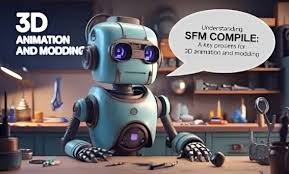Understanding SFM Compile
Source Filmmaker sfm compiles a highly regarded animation tool utilized within the gaming community. An essential component of creating animations in SFM is the compiling process. Compiling, in this context, refers to the transformation of animation data and assets into a format that can be played and rendered within the SFM environment. This specific mechanism is crucial for ensuring that the animations function correctly when executed, providing the creator with accurate visual outputs that align with their artistic vision.
The importance of compiling in SFM cannot be overstated. A well-executed compile can significantly enhance the performance of an animation, addressing issues such as frame rates and timing. Furthermore, this process allows filmmakers to integrate various elements, including models, audio, and effects, into a cohesive final product. By consolidating these components through the SFM compile process, animators can maintain the integrity and quality of their work, thereby avoiding potential mishaps that may arise from uncompiled data.
The overall process of compiling in SFM involves several steps, which typically begin with preparing the assets and animation sequences. After ensuring all resources are correctly organized, users will utilize the built-in compiling tools available in the SFM interface or external software such as the SFM Compiler or tools within Steam. These applications help streamline the process, automatically converting the asset files and animations into a form that is ready for rendering and playback. It is essential for animators to familiarize themselves with these tools, as they may vary in functionality and capabilities.
In conclusion, mastering the SFM compile process is fundamental for anyone aiming to produce high-quality animations. Understanding its fundamentals, significance, and the tools available will facilitate a smoother workflow, leading to more engaging and visually appealing animations.
Step-by-Step Guide to Compiling in SFM
Compiling in Source Filmmaker (SFM) can seem daunting, especially for newcomers, but with a structured approach, it becomes manageable. To begin, ensure you have SFM installed and your project set up properly. Create a new project by selecting ‘File’ and then ‘New.’ This will establish a fresh workspace for your compilation.
Once the project is initialized, the next step involves importing your assets. Use the ‘Import’ option to bring in models, sounds, and animations that you plan to utilize in your film. Pay special attention to ensuring that all assets are compatible with SFM. It is recommended to organize your assets into folders for easy access during the compile stage.
After importing assets, configure the compile settings. Navigate to the ‘SFM Compile’ section found in the ‘File’ menu. You will see various options, including resolutions, frame rates, and output formats. Select the settings that align with your project’s goals. It’s imperative to choose the correct output format since it determines how your film will be displayed to the audience.
With settings in place, it’s time to execute the compile command. This is typically located within the same compile menu. Clicking ‘Compile’ will start the process, which may take some time depending on the complexity of your project. Be patient and watch for any error messages that may arise during this phase.
As your project compiles, observe the log output for any common pitfalls, such as missing assets or errors in the file structure. Should an error occur, take the time to resolve it before attempting to compile again. Troubleshooting is a key skill in mastering SFM compile. Once the compilation process completes without any errors, you can locate your finished product in the specified output directory.
In conclusion, by following these steps diligently—setting up the project, importing assets, configuring settings, and executing the compile command—you can navigate the SFM compile process more effectively. This structure not only assists beginners but also offers experienced users a refresher on best practices in compiling their projects successfully.

Optimizing Your Compile Settings
When working with Source Filmmaker (SFM), understanding the compile settings is crucial for achieving the desired visual outcomes. The compile process is an essential step that transforms your project into a usable format, impacting both the rendering quality and performance of the final output. There are several settings to consider during the SFM compile process that can significantly enhance your project’s quality.
One of the first settings to consider is the resolution. Higher resolutions can result in clearer and more detailed visuals; however, they also require more processing power, which can slow down the compile time. It is advisable to balance resolution settings with your machine’s capabilities and the requirements of your intended final output. For instance, 1080p is often sufficient for online sharing, yet higher resolutions like 4K may be warranted for professional presentations.
Another critical factor is rendering quality. SFM provides various options that can greatly influence the visual fidelity of your project. Higher rendering quality can enhance textures and lighting effects, yet it may considerably increase compile time and resource usage. By adjusting this setting based on the nature of your project, you can optimize the final product without overburdening your system.
Moreover, selecting the appropriate file format plays a pivotal role in the compile process. Different formats can affect compatibility with video players, the preservation of quality, and file size. For standard sharing purposes, formats such as MP4 or MOV are commonly utilized. Conversely, specific projects may benefit from alternative formats depending on their end use.
In conclusion, by carefully fine-tuning the SFM compile settings—resolution, rendering quality, and file formats—users can significantly elevate both the performance and quality of their projects. This detailed understanding will equip creators with the skills necessary to produce optimal results in their Source Filmmaker endeavors.
Common Issues and Solutions in SFM Compile
When working with Source Filmmaker (SFM) compile, users may encounter various issues that can hinder the production process. Addressing these common problems effectively is essential to ensuring a smooth experience. One prevalent issue is related to missing assets. When SFM fails to locate necessary models or textures, it may generate errors that prevent the compile from completing successfully. To tackle this, users should verify that all necessary assets are properly imported into their project and are available in the correct directories. A thorough checklist can help in identifying missing components before initiating the compile process.
Another common challenge involves rendering problems. During the SFM compile, users might experience incorrect lighting, shadow rendering artifacts, or even crashes. To mitigate these issues, it is vital to ensure that the graphics drivers are up-to-date and that system requirements are met. Additionally, users can optimize their project settings within SFM by reducing the complexity of scenes and limiting the number of active lights and particle effects. These steps can significantly reduce the likelihood of rendering problems during the compile.
Moreover, misconfigured lighting settings can lead to subpar visual outcomes. It is advisable to experiment with various settings to find optimal light configurations that enhance the visual quality while maintaining system performance. To provide further clarity, real-life examples demonstrate how adjusting specific settings resolved compile-related challenges for many users, allowing them to produce high-quality animations without unnecessary delays.
Ultimately, familiarizing oneself with potential issues that may arise during sfm compile and implementing effective solutions can empower users to navigate challenges confidently. By enhancing their troubleshooting techniques and understanding the intricacies of the compile process, users will be better equipped to achieve their creative visions successfully.
